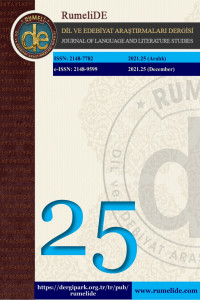Abstract
Edebiyat tarihi içerisinde metinler çeşitli metin çözümleme yöntemleri kullanılarak incelenmiştir. Her çözümleme metne farklı bir pencereden bakma imkânı sunar. Metinlerin farklı metin bilimsel yöntemlerle çözümü onların daha önce fark edilmemiş anlamlarını ortaya koyabilir. Bu çalışmada yüzyıllar önce yazılmış bir metnin çağdaş yöntemlerle çözümleme denemesi yapılmıştır. Yusuf u Zeliha anlatısı mesnevi nazım biçimiyle farklı şairler tarafından pek çok kez konu edilmiştir. Çalışmada, XIII ile XIV. yüzyıllar arasında yaşadığı düşünülen Şeyyâd Hamza tarafından kaleme alınan Yusuf u Zeliha Mesnevisi’nin biçim bilimsel yöntemle çözümlemesi amaçlanmıştır. Biçim bilimsel yöntem kullanarak çözümlenmiş metinler anlatının daha iyi anlaşılmasını sağlar. Aynı zamanda bu yöntem sayesinde metinlerin defalarca okunmasına gerek kalmadan kurgunun doğru anlaşılması ve kişiler arasındaki ilişkinin çözümlenmesi kolaylaşır. Bu nedenle çalışmada öncelikle biçim bilimsel çözümleme ile ilgili yöntemler ve yaklaşımlarıyla öne çıkan Roland Barthes ve Vladimir Propp’ın görüşleri incelenmiştir. İncelemenin ardından Yusuf u Zeliha Mesnevisi’ni çözümlerken hangi esaslara dikkat edileceği belirlenmiştir. Bu esaslar çalışmada yedi başlık altında sunulmuştur. Bu başlıklar; kesitler, sorunlar ve çözümler, mekânlar, zaman, eylem alanları, aranan objeler ve şahıslardır. Çalışmanın sonucunda Eski Anadolu Türkçesi eseri olan Yusuf u Zeliha Mesnevisi’nin çağdaş yöntemlerle yapılan incelemeye elverişli olduğu görülmüştür. Çağdaş yöntemlerin geleneksel metinlere uygunluğunu iddia edebilmek için bu alanda daha fazla inceleme yapılmasına ihtiyaç vardır.
References
- Akerson, F. E. (2015). Edebiyat ve kuramlar. İstanbul: İthaki Yayınları.
- Alibekiroğlu, S., & Çelik, S. (2018). Şeyyâd Hamza'nın Yûsuf ve Zelhâ'sındaki söz varlığına dair bir inceleme. Asia Minor Studies International Journal of Sciences, 6(12), 201-220.
- Barthes, R. (2016). Göstergebilimsel serüven. İstanbul: Yapı Kredi Kültür Sanat Yayıncılık.
- Bayram, Y. (2009). Tahkiye esaslı metinlerin çözümünde biçimbilimsel yöntem ve Hüsn ü Aşk örneği. Journal of Turkish Studies, 4(Türklük Bilgisi Araştırmaları Cem Dilçin Özel Sayısı), 87-105.
- Demirci, Ü. Ö. (2011). Şeyyad Hamza'nın Yusuf u Zeliha'sındaki bazı ibareler üzerine. Atatürk Üniversitesi Türkiyat Araştırmaları Enstitüsü Dergisi(45), 1-8.
- Demirci, Ü. Ö., & Korkmaz, Ş. (2008). Yūsuf u Zelihā. İstanbul: Kaktüs Yayınları.
- Dilçin, D. (1946). Şeyyad Hamza Yusuf u Zeliha. Ankara: Türk Dil Kurumu Yayınları.
- Moran, B. (1994). Edebiyat kuramları ve eleştiri. İstanbul: İletişim Yayınları.
- Özkan, İ. E. (2019). Şeyyad Hamza'nın Yusuf u Zeliha'sındaki bazı sözcüklerle ilgili okuma ve anlamlandırma önerileri. Türk Dünyası Araştırmaları Dergisi, 121(238), 231-236.
- Propp, V. (2018). Masalın biçimbilimi. İstanbul: Türkiye İş Bankası Kültür Yayınları.
- Sandalyeci, S. (2016). Bir Eski Anadolu Türkçesi metni olan Şeyyat Hamza'nın Yûsuf u Zeliha mesnevisinde mental fiiller. Trakya Üniversitesi Edebiyat Fakültesi Dergisi, 6(12), 157-171.
- Tökel, D. A. (2007). Divan Şiiri'ne modern metin çözümleme yöntemlerinden bakmak. Turkish Studies, 2(3), 535-555.
- Türkdoğan, M. G. (2011). Klasik türk edebiyatında Yusuf u Züleyha mesnevileri üzerine mukayeseli bir çalışma. Ankara: T.C. Kültür ve Turizm Bakanlığı Yayınları.
Abstract
In the history of literature, texts have been examined using various text analysis methods. Each analysis offers the opportunity to look at the text from a different viewpoint. The analysis of texts with different textological methods can reveal their previously unrecognized meanings. In this study, an attempt was made to analyse a text written centuries ago with contemporary methods. The narrative of Yusuf and Zeliha, with its form of masnavi verse, has many times been the subject of different poets. In the study, It is aimed to analyze the masnavi of Yusuf and Zeliha, which was written by Şeyyâd Hamza, who is thought to have lived between the XIII. and XIV. centuries, with the morphological method. Texts that are analysed by using the morphological method provide a better understanding of the narrative. Furthermore, thanks to this method, it gets easier to understand the fiction correctly and to analyse the relationship between characters without the need to read the texts repeatedly. For this reason, the views of Roland Barthes and Vladimir Propp, who come to the fore with their methods and approaches related to morphological analysis, were examined in the study. After the examination, it was determined which principles to be considered while analysing the Yusuf and Zeliha masnavi. These principles are presented under seven headings in the study. These titles are sections, problems and solutions, spaces, time, action fields, sought objects and characters. As a result of the study, it has been seen that the Yusuf and Zeliha masnavi, which is a work in Old Anatolian Turkish, is suitable for examination with contemporary methods. More research is needed in this area to claim the compatibility of contemporary methods with traditional texts.
References
- Akerson, F. E. (2015). Edebiyat ve kuramlar. İstanbul: İthaki Yayınları.
- Alibekiroğlu, S., & Çelik, S. (2018). Şeyyâd Hamza'nın Yûsuf ve Zelhâ'sındaki söz varlığına dair bir inceleme. Asia Minor Studies International Journal of Sciences, 6(12), 201-220.
- Barthes, R. (2016). Göstergebilimsel serüven. İstanbul: Yapı Kredi Kültür Sanat Yayıncılık.
- Bayram, Y. (2009). Tahkiye esaslı metinlerin çözümünde biçimbilimsel yöntem ve Hüsn ü Aşk örneği. Journal of Turkish Studies, 4(Türklük Bilgisi Araştırmaları Cem Dilçin Özel Sayısı), 87-105.
- Demirci, Ü. Ö. (2011). Şeyyad Hamza'nın Yusuf u Zeliha'sındaki bazı ibareler üzerine. Atatürk Üniversitesi Türkiyat Araştırmaları Enstitüsü Dergisi(45), 1-8.
- Demirci, Ü. Ö., & Korkmaz, Ş. (2008). Yūsuf u Zelihā. İstanbul: Kaktüs Yayınları.
- Dilçin, D. (1946). Şeyyad Hamza Yusuf u Zeliha. Ankara: Türk Dil Kurumu Yayınları.
- Moran, B. (1994). Edebiyat kuramları ve eleştiri. İstanbul: İletişim Yayınları.
- Özkan, İ. E. (2019). Şeyyad Hamza'nın Yusuf u Zeliha'sındaki bazı sözcüklerle ilgili okuma ve anlamlandırma önerileri. Türk Dünyası Araştırmaları Dergisi, 121(238), 231-236.
- Propp, V. (2018). Masalın biçimbilimi. İstanbul: Türkiye İş Bankası Kültür Yayınları.
- Sandalyeci, S. (2016). Bir Eski Anadolu Türkçesi metni olan Şeyyat Hamza'nın Yûsuf u Zeliha mesnevisinde mental fiiller. Trakya Üniversitesi Edebiyat Fakültesi Dergisi, 6(12), 157-171.
- Tökel, D. A. (2007). Divan Şiiri'ne modern metin çözümleme yöntemlerinden bakmak. Turkish Studies, 2(3), 535-555.
- Türkdoğan, M. G. (2011). Klasik türk edebiyatında Yusuf u Züleyha mesnevileri üzerine mukayeseli bir çalışma. Ankara: T.C. Kültür ve Turizm Bakanlığı Yayınları.
Details
| Primary Language | Turkish |
|---|---|
| Subjects | Linguistics |
| Journal Section | Research Article |
| Authors | |
| Publication Date | December 21, 2021 |
| Published in Issue | Year 2021 Issue: 25 |

